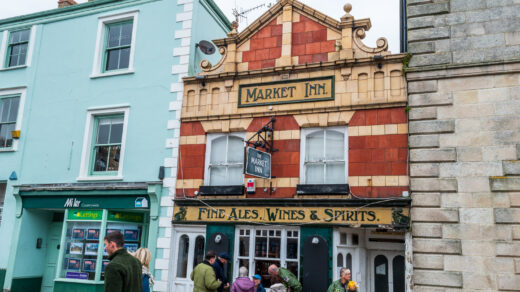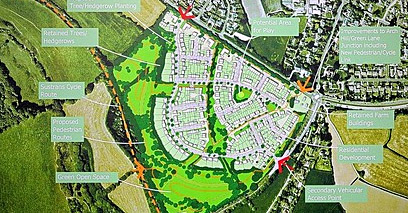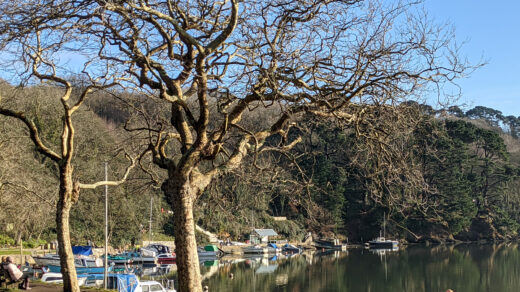Truro & Global Warming – a solution?
THE MISSING ELEPHANT
A personal view by Michael Burgess
On Wednesday 7 January 2015 Roger Gazzard, Clerk to Truro City Council gave a briefing to Truro Civic Society on the Truro and Kenwyn Neighbourhood Plan. It was a very useful session and several good points were made. The plan covers the period up to 2030, I was surprised that no mention was made of any preparative planning for the risks to Truro from floods due to global warming and increased traffic flows. Apparently due to the lack of funds to do anything major about these problems it is deemed not to be a subject suitable for inclusion in the Neighbourhood Plan and public debate. Coincidently 7 January was the very day when measurements at the Mauna Loa Observatory, of atmospheric CO2 levels passed 400 ppm. Scientists have been saying for some time that any measurement above 350 ppm would enhance the risk of the world warming more than 2 degrees C, a critical level. Surely the people of Truro and Kenwyn need to, at least, start to consider the options to mitigate this danger. It took 29 years for the Thames Barrier to be completed after the disastrous floods on the East Coast in 1953. Engineers are already planning for an upgrade to Thames flood protection over the next few decades.
The Department of Transport Forecast for road transport covers the period 2010 to 2040, the latest revision came out in 2013. Its central forecast, for England, is an increase in traffic of 42.8%, it is difficult to see Truro, Falmouth and places to the south being different. It is a sophisticated piece of work, for example it even allows for the completion of HS2, it might be useful to consider some of their assumptions:
A current understanding of how people make travel choices. The expected path of key drivers of travel demand. It assumes no changes of government policy. An increase in population of 10.5 million. A rise in GDP per capita of 66% (based on OBR figures) and a reduction in the cost of driving cars of 24%.
One might argue with these assumptions, however they do provide a reasonable basis for us to plan our infrastructure. Locally the proposed park and ride projects, the plan proposal to make more use of the railways, buses and docks, more walking and cycling will make a difference to vehicle use. However hard evidence from the real world shows that that these hopes, however commendable, will only make a marginal difference. In 2014 sales of cars and miles driven were at an all-time high. The key roads through Truro will become ever more congested, this will pose a threat to the heart of our beautiful city.
There have been 35 significant flood events in Truro in the last two hundred years. Flood relief schemes are now in place on the Kenwyn and Allen rivers and the tidal barrier at Boscawen Park was recently raised to 1.2 meters. This may not be enough. Whilst the weather is always changeable and unpredictable the general trend of climate change seems now to be agreed amongst all serious scientists. Eventually the Earth might return to conditions that prevailed in previous warm periods. The Eemian, 125,000 years ago might be an example of the kind of future that awaits us; temperatures were on average up to 2 degrees higher than today, possibly higher at the poles. Sea level at peak was probably 4 to 6m higher than today, caused by some melting of the polar ice caps, glaciers and thermal expansion of the oceans. Sea conditions might have been different then, so it is not a perfect analogue but a warning that citizens that live on the edge of the sea cannot be complacent.
The real issue is the speed at which temperatures could rise and the ultimate effect on sea levels. In the past changes would take place at a geological pace over thousands of years. Mankind has been digging up coal, oil and gas in industrial quantities only for the last two hundred years. It took nature millions of years to lay down these reserves. The amount of CO2 in the atmosphere has increased by over 40% since pre-industrial times and the rate is accelerating. This is a level that has not been seen for three quarters of a million years. Such a rapid increase is unprecedented and could lead to dangerous changes that may continue for centuries.
The IPCC issued its Fifth Assessment Report in late 2014. Global sea level is projected to rise at a greater rate during the 21st century than previously. Typical scenarios see a rise of between 0.28m and 0.98m above 1990 levels. However due to limited understanding of the relevant process, quantitative projections of land ice mass loss are largely excluded. To an already higher tide there must also be added any storm surge coming up Carrick Roads. Hurricane Sandy in 2012, produced a 4m storm surge that flooded Manhattan over a 1.5m flood barrier causing $40 billion of damage. The 1953 storm flooded towns like Mable Thorpe, Lincs, protected by a 7m sand bund. Warmer oceans and atmosphere will increase evaporation leading to ever bigger storms and higher rainfall in the future. Last year was the warmest since records begun.
There are no grounds for optimism. No nation is reducing their greenhouse gas emissions enough. The leaders of China and India have stated quite explicitly that their emissions will continue to rise until at least 2030. The world consumes on a daily basis 90 million barrels of oil and 21 million tons of coal, plus in winter, huge amounts of gas. CO2 remains in the atmosphere for over a hundred years so it important to start reducing the amount of fossil fuels consumed. To make a serious dent with renewables will require an enormous investment. A pair of scientists have calculated that the world would require about 6 million 1 megawatt wind turbines and some 2 million hectares of land covered in solar panels to provide the energy currently available from fossil fuels. This plus more nuclear power and perhaps new technologies is an enormous burden for the world’s political, engineering and financial resources. It may be impossible to prevent the inevitable rise in greenhouse gases and rising temperatures above the 2 degree target.
We in Truro should start our planning for this future. We will definitely need bigger flood barriers at some point. It might also be wise to plan for a new Truro bypass. I published a paper on the Civic Society website in November 2012 titled “To kill two birds with one stone”. It was a plan to combine a flood barrier across the river with a proposed southern bypass to alleviate traffic congestion. It is just one plan, there may be others, and it would a good thing for there to be some public discussion.
In summary I proposed a barrier or dyke across the river near Sunny Corner constructed like those used in Holland of sand like material. It would need a lot of sand, it might be an idea to consider using the one million tons of dredged  material that will be produced at Falmouth docks, if that scheme goes ahead. It would avoid the environmental disaster of dumping it on the fishing grounds. Other dykes might be needed to protect Calenick, St Clement and Tresillian.
material that will be produced at Falmouth docks, if that scheme goes ahead. It would avoid the environmental disaster of dumping it on the fishing grounds. Other dykes might be needed to protect Calenick, St Clement and Tresillian.
A southern bypass has been considered and rejected in the past, probably on the grounds of the cost of bridging the river. A road from the site of the new Waitrose, across the fields down to Sunny Corner would be like the Probus bypass with similar costs. The crossing over the dyke would require a lifting bridge over any lock gates for access to the docks. This might be expensive but it is a routine engineering project. The road would run around the sewerage works then alongside the old railway track behind County Hall. It would provide a good access for heavy vehicles into Newham from the far end. This is an environmentally sensitive valley and the trees along the line would mask the road. The actual line should be surfaced to provide a cycle track for everyday use. If the cycle way was extended alongside the whole of the new road it could be used by pupils at Penair, Richard Lander and Truro College. An additional spur of the cycle way up the river as far as Tesco could be used by shoppers and commuters right into the centre of the city. The new road would require a bridge over the railway line to Penzance, the costings could be similar to the new embankment and bridge built over the Carnon valley. The road could then follow the main railway line until it turns north to link with Higher Besore Road at Richard Lander School. Eventually these hard times will pass and money will become available; there will be competition from projects in other places. We should be ready with our bid. The current government is prepared to spend £540 million on a Stonehenge bypass. Is Truro Cathedral any less important?








Recent Comments